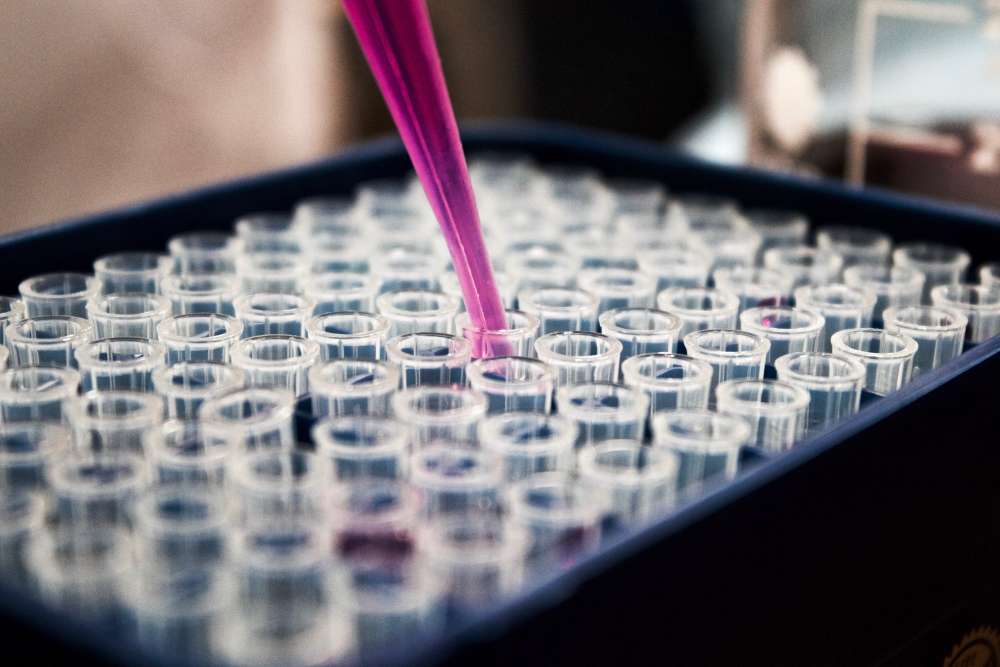Pandemic Pathogens as Biological Weapons: Revisiting German Biodefense
Catastrophic pandemics are becoming more likely. Soon, advances in biotechnology could enable thousands of individuals to create pandemic viruses from scratch and misuse them as biological weapons.
The COVID-19 pandemic has been a sobering experience, but it is not a once-in-a-century event. Infectious disease outbreaks have a devastating, millennia-long track record, and experts agree that their frequency will likely increase in the future. Yet, even with health security becoming a much-debated political issue, new variants like Omicron have caught governments worldwide off guard. As a consequence, the COVID-19 pandemic has been an unfathomable human tragedy: in Germany alone, more than 160,000 people have died in connection with COVID-19 to date. Even so, infection with SARS-CoV‑2 has a low case fatality rate compared to pathogens like Ebola. In comparison, pandemic viruses that are more lethal or contagious would pose a much greater hazard. Alarmingly, experts agree that the next pandemic is only a matter of time: Animal-borne pathogens have caused the majority of emerging infectious diseases to date, and global issues like climate change and loss in biodiversity increase the likelihood of animal-to-human transmission. In addition, human-engineered viruses also pose a growing threat. Advances in biotechnology make it increasingly easy to build viruses from scratch or to alter known pathogens. In the future, artificially optimized pathogens with higher transmissibility or case fatality rates could cause the greatest catastrophes.
However, humanity is not condemned to helplessly watch as new pandemics unfold. Investments in defensive technologies and increased diplomatic efforts can close technical and political gaps in global health security. The German government should take its first National Security Strategy as an occasion to improve its biodefense systems substantially.
» In the future, artificially optimized pathogens with higher transmissibility or case fatality rates could cause the greatest catastrophes. «
Biotechnology at the Crossroads of Progress and Risks
The rapid development of SARS-CoV‑2 mRNA vaccines exemplifies the unprecedented progress in biotechnology. While this progress has the potential to revolutionize human health, it comes with perils. The democratization of bioengineering allows an increasing number of individuals to build pathogens like corona or influenza viruses from scratch. Meanwhile, appropriate safeguards are not in place: free online protocols provide step-by-step instructions for creating contagious viruses, and the synthetic DNA required to build these pathogens can easily be ordered by mail.
This is cause for concern. Indeed, historical examples demonstrate how biology has repeatedly been misused as a weapon – including in Germany. In 2018, the German Federal Criminal Police Office found large quantities of the biological toxin ricin in the possession of a couple associated with the Islamist-extremist scene. If deployed, the secured poison could have caused up to 27,000 deaths and injuries. And in January of this year, two Iranian brothers were arrested in North Rhine-Westphalia for allegedly planning an Islamist-motivated attack using ricin seeds.
Clearly, malicious actors do not shy away from using biological weapons. While the effects of poisons like ricin or anthrax are geographically limited, self-propagating pathogens from the lab could have far more devastating consequences. Therefore, recent technical advances bring the inherent dual-use potential of biotechnology to the fore: malicious actors can exploit the results of well-meaning scientists to deliberately harm the population or environment.
Key Points:
- The democratization of biotechnology increases the risk that malicious actors will misuse pandemic pathogens as biological weapons.
- The German government can substantially improve its biodefense by strengthening the Biological Weapons Convention, improving oversight of dual-use research of concern, and investing in defensive technologies.
Emerging Threats from Human-Engineered Viruses
Certain research projects proactively seek to create enhanced viruses in the lab. For instance, scientists continue to tinker with extremely lethal, but poorly transmissible pathogens to increase their transmissibility. By investigating altered or new viral genome sequences, researchers aim to predict future pandemics more accurately. Additionally, they hope to make effective drugs and vaccines available sooner – and thus save more lives. However, scientists may discount the fact that publishing these genome sequences could provide malicious actors with a credible blueprint to re-create and misuse these hazardous pathogens and spark a new pandemic.
Similarly concerning is the fact that the safety standards of research facilities are often inadequate. Dangerous viruses are repeatedly released from high-containment labs by accident. In the absence of appropriate safeguards, research on enhanced potential pandemic pathogens thus poses a high risk of both inadvertent release and deliberate misuse. Accordingly, the German Research Foundation and National Academy of Sciences Leopoldina classify experiments with enhanced potential pandemic pathogens as security-relevant research (more commonly referred to as dual-use research of concern).
Revisiting German Biosecurity
In Germany, the COVID-19 pandemic has caused economic losses of 330 billion euros in 2020 and 2021 alone. In light of the increasing likelihood of new pandemics, long-term financial investments and holistic approaches to improve health security are needed. To its credit, Germany learned some lessons from its shortcomings in dealing with the COVID-19 pandemic. Indeed, pandemic preparedness and biological security were priorities during Germany’s 2022 G7 presidency. This renewed German interest in international health security is more than a symbolic gesture: it complements efforts like the German Biodefense Program, which aims to mitigate biological risks by supporting partner countries in Africa, Central Asia, and Eastern Europe. Yet, in domestic politics, pandemic preparedness has long received too little attention. The Global Health Security Index 2021 attests to Germany’s shortcomings in national pandemic prevention and response. Consequently, the German government should increase its investments in national health security. In doing so, it should focus on measures that guard against the full spectrum of biological threats, including human-made pandemics.
» The focus should be on measures that guard against the full spectrum of biological threats, including human-made pandemics. «
Solutions in the Context of the National Security Strategy
There is no silver bullet to protect the world from all future pandemics. However, Germany can build multi-layered defense systems by increasing its diplomatic efforts and investing in defensive technologies – buzzword “differential technological development.” The following proposals are not military, but civilian in nature. They can improve Germany’s national security without sending escalating signals:
Strengthening the Biological Weapons Convention
Throughout history, state actors have produced and used bioweapons. To prevent this, the Biological Weapons Convention entered into force in 1975. This international treaty prohibits the production, stockpiling, and use of biological weapons. However, in the absence of a verification mechanism that monitors compliance, the convention lacks enforcement capability. Germany should increase its diplomatic efforts toward a verification mechanism and build bridges between opposing diplomatic camps. Moreover, the Biological Weapons Convention is chronically underfunded – with a budget smaller than that of the average McDonald’s restaurant. Germany has been a pivotal voluntary sponsor of the convention in the past and should now continue and expand its financial support.
Improved Oversight of Dual-Use Research of Concern
In 2014, the German Ethics Council concluded that Germany’s dual-use oversight was insufficient. Since then, improvements have been made: many research institutes have set up voluntary ethics committees in security-relevant research. Still, dual-use oversight in Germany is not harmonized between different research institutions or federal states. A national, legally binding regulation – as postulated by the Ethics Council – could solve this problem.
Furthermore, pathogens do not respect international borders, and German national security also depends on the biosecurity strategies of other nations. In many EU member states, dual-use research of concern is not sufficiently regulated. This clearly contradicts the precautionary principle that has defined European environmental policy for decades: if damage to humans or the environment is possible, preventive measures should be taken to avoid harm, despite a lack of certainty. Thus, Germany should initiate the political re-evaluation of dual-use oversight at the EU level.
Investments in Technologies for Pandemic Detection and Response
The Omicron variant infected about a quarter of the US population within only 100 days, and Europe was similarly plagued by its rapid spread. Pathogen-specific countermeasures like vaccines take time and thus are often insufficient to halt the exponential spread of viruses. However, Germany can invest in protective measures that take effect against any type of pathogen: for instance, developing and stockpiling improved personal protective equipment could help to maintain critical infrastructure during an outbreak. Further, wastewater monitoring for novel pathogens can identify outbreaks early on, allowing policymakers and scientists to take quick and targeted countermeasures. Ongoing pilot projects in Germany detect SARS-CoV‑2 RNA in wastewater, but cannot identify the spread of previously unknown pathogens. Instead, Germany should follow the UK’s example and increase its investments in metagenomic sequencing. In contrast to established approaches, this new technology identifies all nucleic acids in a sample, thereby also detecting the proliferation of novel pathogens.
It is worth emphasizing that ideally, German and EU policymakers would act in concert to implement these measures. In a promising step, the EU established the Health Emergency Preparedness and Response Authority (HERA) in 2021 to close gaps in European health security.
A Zeitenwende for German Biodefense
With its first National Security Strategy, the German government has the opportunity to lay the foundation for a far-sighted biodefense strategy. In doing so, Germany should work closely with international partners such as the Biden Administration, which has called for global cooperation on pandemic preparedness in its 2022 National Security Strategy: “no one is safe until everyone is safe.”
To guard humanity against future biological risks, German Chancellor Olaf Scholz’s much-quoted Zeitenwende (turning point) in national security must be accompanied by a rethink of German biodefense.
Janika Schmitt
Researcher in Biosecurity, Universität Heidelberg
Jonas Sandbrink
Researcher in Biosecurity, University of Oxford
Keep on reading

In a Globalized World, No Security Without Climate Security
Because they are driven by narrow concepts of security, security strategies typically end up looking for answers to new threats in the same old places. But Germany still has a chance to do it differently.

Embrace Multipolarity: Germany Must Act European for the Global Common Good
To promote a more peaceful world, Germany needs to move past primarily national strategies and start thinking European. The best way to do that: support a strong global role for the European Union.

Securing Supply Chains for the Low-Carbon Economy: The Case of Electric Batteries
The transition to low-carbon technologies is creating new dependencies for the European economy. Especially critical for Germany: electric batteries. To reduce risks and reshape emerging global value chains, Berlin and other EU governments must prioritize a comprehensive governance approach.
